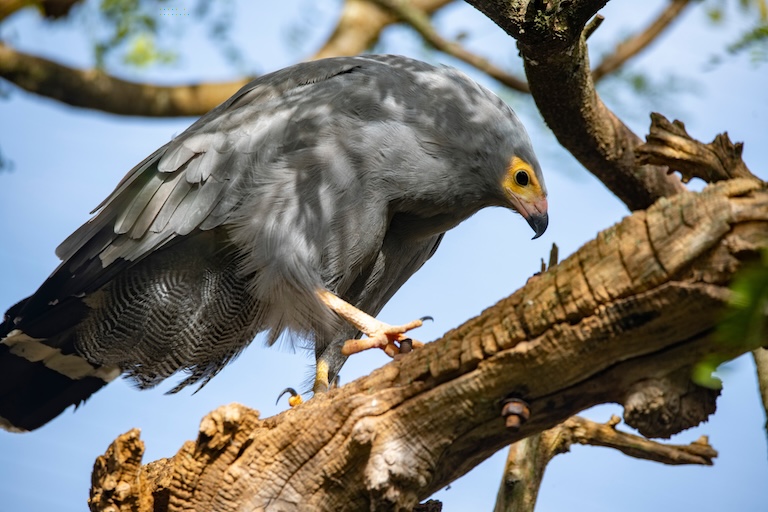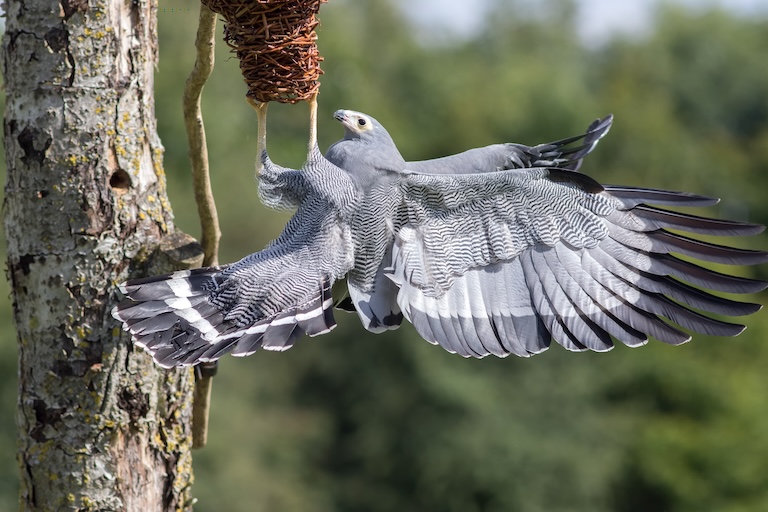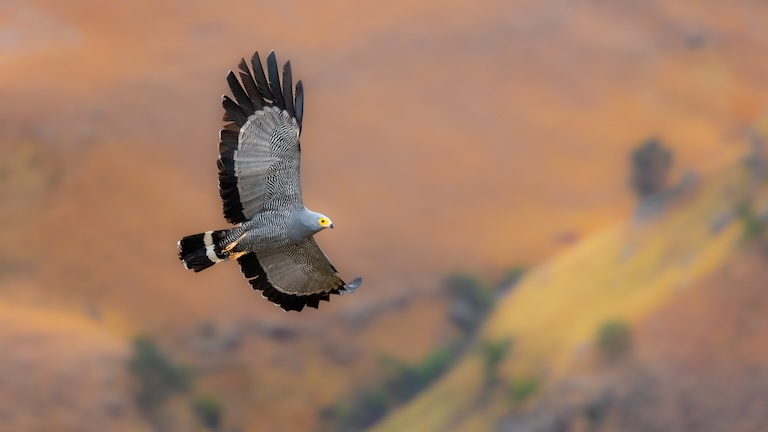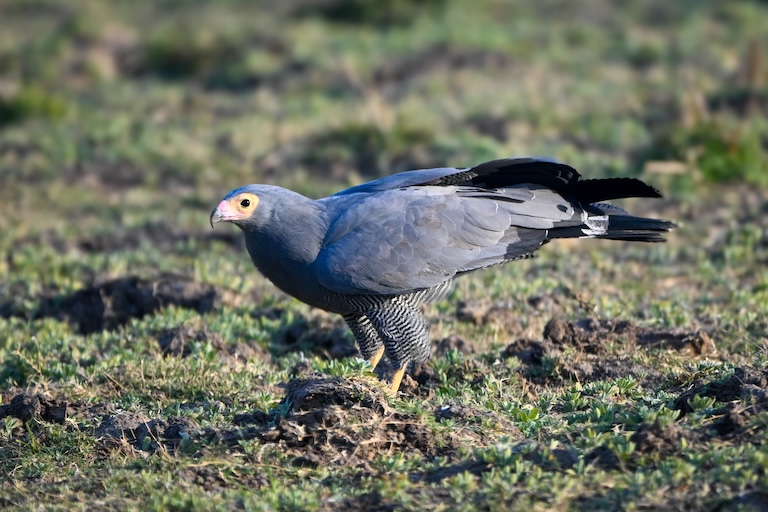African Harrier-Hawk Profile
One of the most common African raptors is also one of the strangest.
While many large birds are struggling to survive in Africa’s rapidly changing ecosystems, the African harrier-hawk isn’t afraid to be different, and this highly adaptable bird has a unique set of features that give it the edge in almost any habitat.

African Harrier-Hawk Facts Overview
| Habitat: | Highly variable: forests, savannas, urban gardens, etc. |
| Location: | Sub-Saharan Africa |
| Lifespan: | Unknown |
| Size: | 66 cm (26 in) long |
| Weight: | 500–820 g (17.6–28.9 oz) |
| Colour: | Grey with black wing tips, a black tail fan with a white bar. |
| Diet: | Small vertebrates and fruit |
| Predators: | None |
| Top Speed: | Unknown |
| No. of Species: | 1 |
| Conservation Status: | Least Concern (IUCN) |
The African harrier-hawk has long, slender legs and a narrow face with small eyes. In many ways, it looks like a New World vulture, and there are similarities in the way the two groups feed that are not obvious at first.
Other quirks are the food types that are chosen and the foraging methods employed.
This bird is the only member of its genus on the mainland, and its fortunate array of weaponry has allowed it to thrive in almost any type of habitat, using highly specialized features to adopt a highly generalized behavioral repertoire.
Interesting African Harrier-Hawk Facts
1. They’re unusual
African harrier-hawks share a genus with one other species on the African continent, the Madagascar harrier-hawk.
The two were once the same species, separated geographically until their genes drifted far enough apart for them to be considered by many to be distinct.
There isn’t a consensus on this, and there’s talk that the Madagascan harrier-hawk is merely a subspecies of the African harrier-hawk.
Taxonomic convention dictates the oldest species name is chosen when two previously separated species are combined, so if this is true, it would mean the African harrier-hawk would have to take the Madagascan harrier-hawk’s species name.
It’s likely in this instance that the African harrier-hawk would be referred to as Polyboroides radiatus typus.
Whatever the case, these two (or one) species are very different from most raptors in Africa and have quite a bit in common with the distantly related New World raptors.

2. They have bald faces
African harrier-hawks look a lot like the New World vultures in many ways, despite being unrelated. They have narrow heads, small eyes, and bald faces.
These are characteristics that don’t stem from their common ancestor with the New World vultures but from convergent evolution of two groups: independently evolved solutions to similar environmental problems.
And when you look at the lifestyle of this unusual African raptor, it becomes clear as to why. Narrow heads and bald faces are excellent adaptations for sticking your head into something.
With the vultures, this is usually the anus of a deceased mammal. For the African harrier-hawk, it’s only slightly more ceremonious.
But before we get to that, the next clue to this bird’s hunting methods is at the other end.
3. They’re double-jointed
If you compare the flexibility of a dog’s front feet to that of a cat’s you can see that one is designed for running long distances and the other is designed for grabbing, jumping, and grooming. Specifically, this ability to rotate the limb in cats is called antebrachial rotation.
If you’ve ever seen a cat reaching under a cabinet, you’ll know how this comes in handy.
Similarly, the African harrier hawk has incredible flexibility in its ankle joint, which bends forwards, sideways, and backwards for the same reason: reaching into cavities and pulling out helpless little mammals or birds who were living in there.
This extra flexibility is granted by the extremely narrow intertarsal joint, rather than the muscles and ligaments themselves. 1
4. They have weird eyes
One of the reasons lots of raptors look so angry is the pronounced brow ridge that gives them a focused and aggressive facial expression. This ridge is a built-in sun visor and protects the eyes while they’re busy spotting prey from the air.
African harrier-hawks don’t have this ridge, and so, despite having smaller eyes than many of their kind, they have a much higher degree of visual field above their heads.
Compared with, say, a yellow-billed kite, African harrier-hawks have 25° more vision above their heads, for a total of around 120°.
The reason for this extra angle ties into their bendy limbs and relates to their method of finding food.
5. This is for hanging upside down
This extra angle of vision is up to twice as great as some of the other raptors, and all because of how much farther “up” it can see.
Most raptors are interested in finding food that’s beneath them, but all of the weird quirks in the African harrier-hawk make sense when you see it hanging upside down under a hole in a tree or a weaver bird nest, looking up into the hole, and then reaching in and grabbing what’s inside.
Essentially, the extra range of vision allows it to look up, keeping its feet in sight while probing around in crevices above it. This is a remarkably specialized foraging strategy for a bird this size and further explains why their heads are so small and their faces so bald. 2

6. They are highly adaptable and intelligent
While these are highly specialized adaptations, they allow the bird to be incredibly generalized with its approach.
There are four described hunting strategies, including the classic raptorial soaring approaches from either a high or low altitude.
High soaring is used when hunting reptiles on the ground, which the raptor will descend upon quickly from as much as 100 meters.
Being more easily blinded by the sun, this species prefers low soaring over high soaring, especially when searching for bird nests, but this comes with the risk of being mobbed by the locals, and small birds will often come out to chase them off.
However, this can backfire on the passerines, as the hawk can tell by how vehemently they oppose its presence where all the good nests are and will take a lack of aggression as a sign that they’re losing the trail.
Finally, they will also forage from the canopy or ground directly, and this is where the small head and bendy feet are best used.
And even after all this, the bird has yet another quirk in its arsenal. 3
7. But they also eat fruit
Unlike most raptors, this one will chow down on palm fruits as readily as baby birds. All of the tools that make it a terrifying predator to small, enclosed birds give it just what it needs to hang off a palm oil plant and pick the fruits off.
It’s little wonder that the species is so widespread and successful and currently of no conservation concern.

African Harrier-Hawk Fact-File Summary
Scientific Classification
| Kingdom: | Animalia |
| Phylum: | Chordata |
| Class: | Aves |
| Order: | Accipitriformes |
| Family: | Accipitridae |
| Genus: | Polyboroides |
| Species: | typus |
Fact Sources & References
- P. J. K. BURTON (1976), “THE INTERTARSAL JOINT OF THE HARRIER-HAWKS POLYBOROIDES SPP. AND THE CRANE HAWK GERANOSPIZA CAERULESCENS”, Sci Hub.
- WildEarth (2018), “An African Harrier Hawk Finds What its Looking For”, YouTube.
- Thomas L. Thurow (2010), “ECOLOGY AND BEHAVIOUR OF THE GYMNOGENE”, Taylor & Francis.
